
Walcott to Encampment Stage
William C. Henry (1859-19?) whose real estate and mining stock sales office is depicted to the left of the horses was an initial investor
in the development of Encampment, served as its first mayor and served as a state senator from
Carbon County. He additionally was President of the
Copper State Bank which became the Noth American Trust Company. He was Vice-President of the Saratoga and
Encampment Railway and was involved in the Consoidated Gold, Copper
& coal Co.
With the closure of the smelter in 1908, copper mining in the Grand Encampment Mining District
was no longer commercially viable. Encampment served as the marketing center for the various small
mining towns within wagon distance. They, one by one, Dillon, Rudafeha, Battle Lake, and Copperton faded away and died.
For a time, Encampment remained as a supplier for the needs of the railroad tie industry. The tie industry near
Encampment dates to the construction of the Union Pacifc Railroad fifty miles to the north. Originally, the principal
area for cutting of ties was along the western side of the Medicine Bows. Along the various tributaries of the
Encampment River tie camps were situated. During the winter, ties would be shaped and stacked awaiting the
spring thaw along the river.
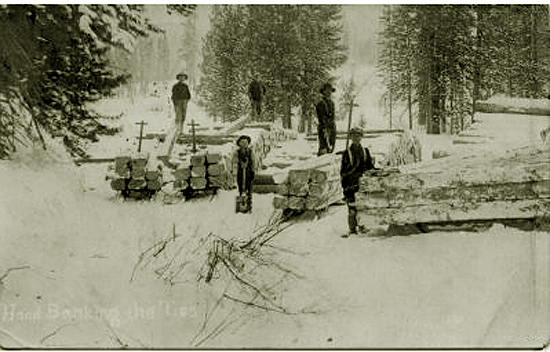
Stacked ties near Encampment, 1911
In the spring, the ties would be floated down the river to the
North Platte.
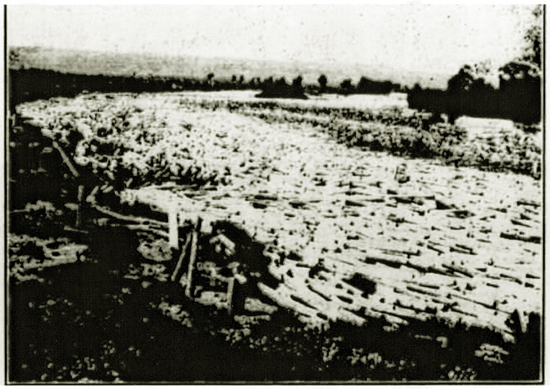
One half million railroad ties on the North Platte near
Encampment. Photo by Merritt D. Houghton, 1903.
On the North Platte the ties would be floated northward to Fort Steele to be loaded on trains for shipment to a tie treatment plant in
Laramie.
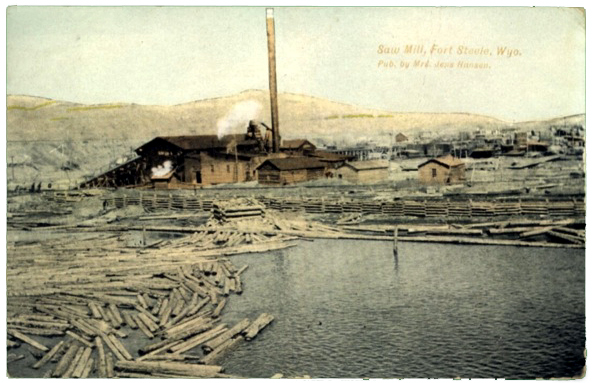
Fort Steele Mill, approx. 1910.
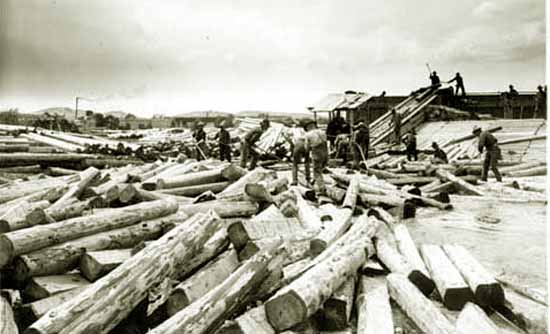
Loading Railroad Ties at Fort Steele, 1905.
Prior to 1916, the main contractor for
railroad ties was the Carbon Timber Company. The peak years for the Carbon Timber Company was between
1900 and 1906.
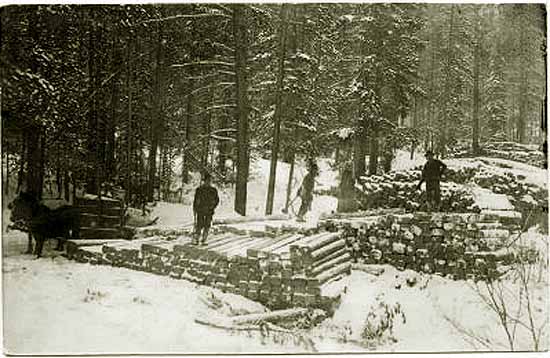
Tie Hacks near Encampment, 1912.
And just as Encampment was hurt by the loss of the copper industry, it was also hurt by
a change in the tie industry. In 1910, the Laramie, Hahns Peak and Pacific Railroad reached Fox Park on the eastern
side of the Medicine Bows. Fox Park became a headquarters camp and commissary for the tie industry. Operations gradually moved to the
eastern side. In 1916, the Carbon Timber Company became insolvent. See American Surety Co. v.
Carbon Timber Co., 263 F. 295 (8th Cir. 1919). Better roads and the introduction of gasoline portable saw mills also reduced employment for
tie hacks who hand shaped the ties with broad axes. Although some tie camps remained along the tribuaries of the Encampment River,
it was another kick in the teeth for the town. The final blow to the tie camps came in 1940 when the Union Pacific discontinued the use of
handhewn railroad ties. It was for the tie hacks a hard and dangerous life.
As noted in A cultural Resource Inventory for the Barrett Ridge Timber Sale, Dean McKee, United States Forestry Service District Archeologist,
December 1989, pp 15 and 16, the tie hacks "lead an isolated and hazardous life. Injuries frequently occurred during cutting
operations and the river tie drives were extremely hazardous. Winter conditions were often severe."
Today, one may go out along the upper reaches of the Encampment River or into the
Medicine Bows and find the remains of a once triving industry.
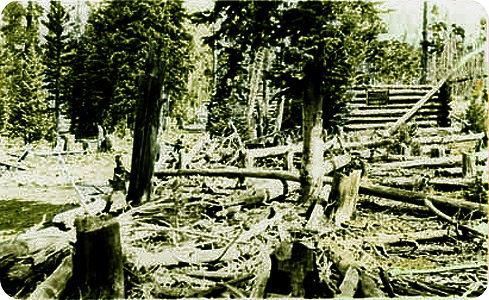
remains of Tie Camp near Encampment, undated.
Other efforts for economic gain were made. In 1905, Encampment was the site of the third largest rabbit ranch in the
country. The ranch operated by W. H. Butler ran three thousand head of hares. He expected that by the following year, he would have
a herd of 10,000. Today, W. H. Butler is remembered in the name of the Butler Bridge over the Encampment River. The bridge was constructed
in 1930 replacing an earlier wooden bridge constructed by Butler in 1905. The original bridge provided a route to Rawlins.
After Butler began charging a toll of fifty cents for passage over his bridge, Carbon County was enduced by local residents to buy
Butler out. The current steel truss bridge is on the National Register.
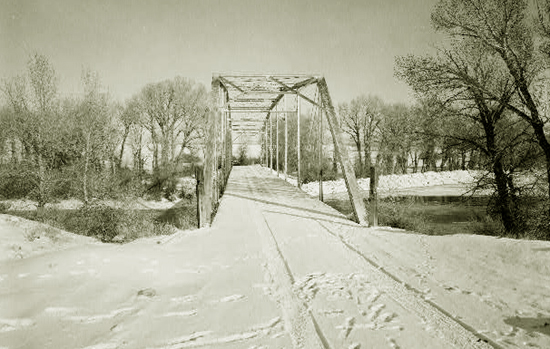
Butler Bridge, Photo courtesy Library of Congress.
The waters of the Encampment River continue to placidly flow into the Platte on the way to the Gulf Of Mexico, but no longer is the
river jammed with railway ties.
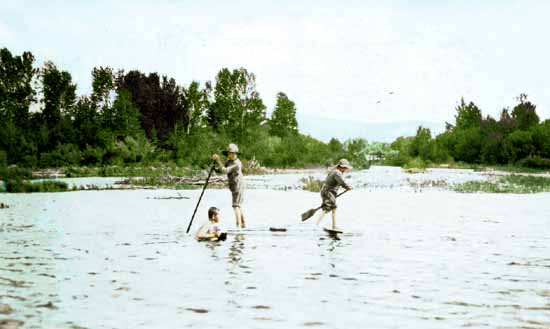
Encampment River, undated.
With no railroad, the smaller mines, even with the smelter,were not economically viable. Beginning about 1904 signs of the loss of population
were on the horizon. Word of amazing gold stries in
Nevada were reported in the Encampment Herald. To prospectors there is always a new strike just over the hill. Every week or so, the Herald
reported the prosperity of Goldfield, Nevada. The paper reported that Willis George Emerson made
$175,000 in six months and was moving on to the next strike at Manhattan, Nevada. By September of 1904, Ed Haggarty was at
Goldfield. Later he moved on. By 1915 Haggarty was in Juneau, Alaska. Henry Britt executed a deed in lieu of foreclosure on his drugstore and
moved to the Skidoo Mining District in Death Valley. The Rawlins-Dillon stage ceased operations due to lack of business. In January of
1905, Joe Enkhouse closed his livery barn and shipped his horses to Goldfield. The publisher of the Herald, Edwin Drury even checked out
Skidoo shipping printing equipment there.
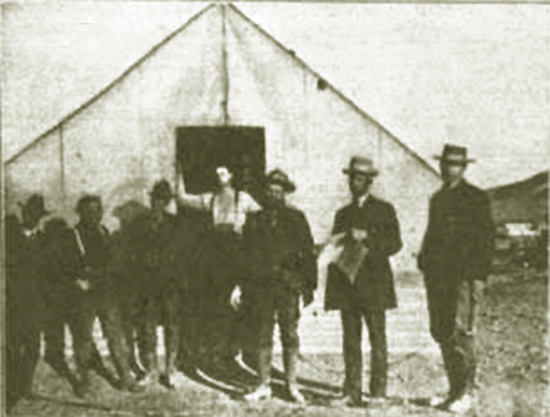
Skidoo News, 1906. Edwin Drury, second from left.
Drury however continued to operate the Herald, not withstanding that his brother W. C. Drury moved to Dayton, Ohio, F. W. sherrod sold his barbershop and moved to Michigan.
During 1905 and 1906 reports of persons moving on
were almost weekly. The movers and shakers of Encampment also moved on. Charles Edward Winter moved to Casper about 1916, became a District Judge, a
Congressman, and later Governor of Puerto Rico. In 1902, Professor W. S. Eberman appeared in Sumpter, Oregon where he was involved in the
promotion of the Overland Gold Mining Co. and a smelter for the Oregon Smelting and Refining Company. Both were apparently highly leveraged.
In 1904, mail to the Gold Mining Company was being returned unclaimed. The smelter closed in
1907 and was foreclosed upon in 1909. It was later sold for taxes.
Willis George Emerson, today primarily recognized as a novelist, moved to
California in 1904. In 1915, he published his "Treasure of Hidden Valley" set in the Encampment area.
The novel includes as characters Jim Rankin, Tom Sun, Boney Earnest and Grant Jones, the
publisher of the
Dillon Doublejack. A year later, Emerson announced that he was
working on a new mining venture which would be bigger than Cripple Creek. It was not to be. The Emerson Motors scandal dashed any hopes for a
comeback.
Barney McCaffrey moved to Denver. He paid a
visit to Encampment on April 6, 1908 in the company of former mayor and Senator W. C. Henry. The writer for the
Encampment Herald did not recognize him.
McCaffrey died
in 1911, respected and leaving an estate of about $360,000. At the end of 1912, the Encampment Herald ceased publication. Edwin Drury moved to
Cheyenne and became the business manager of the Leader. He told the Wyoming Tribune:
When the Haggarty mine was running at Encampment some years ago the city had a population of
over two thousand and everything was in a properous condition. The city apparently had a bright
future and it was considered the most promising city in the state. Real estate sold well, and every branch of business felt the effects of general
prosperity. Then the litigation came and the mine was closed. Business began to fall away. the city now has scarely two hundred
inhabitants and real estate does not sell at all.
The city is absolutely dead at present. Owners of houses give the rent free to tenants to keep up the insurance.
The Herald office once had a mechanical force of eight men but for the last year a fifteen year old girl was the only
assisant I had in getting out the
paper. Owners of houses are vainly offering to sell them for a very small faction of their cost.
Although Senator Henry's wife visited the town several times over the next several years, each
time without her husband, Senator Henry's visit in 1908 in so far as is known was his last visit to Encampment.
Over the next several years various
unsubstantiated reports were received that
he was in British Honduras, Spanish Honduras, Guatemala, or Kansas city. In 1921, The Wyoming Tribune printed a brief item:
Does Any Body Here Know Whereabouts Senator W. C. Henry
If anyone knows the present whereabouts or any information concerning W. C. Henry, formerly of
Encampment Wyoming, and who was once a state senator from Carbon County, they will confer a great favor by communicating the same to his daughter, Mrs. H. E. Hinkel, No. 233
Areba Street, Hershey, Pennyslvania.
Mrs. Hinkel has been separated from her father since childhood. She has an important communication for him, and will be very greateful for any news concerning him.
A similar item appeared in the Laramie Boomerang. No response to the inquiry appeared
in either paper.
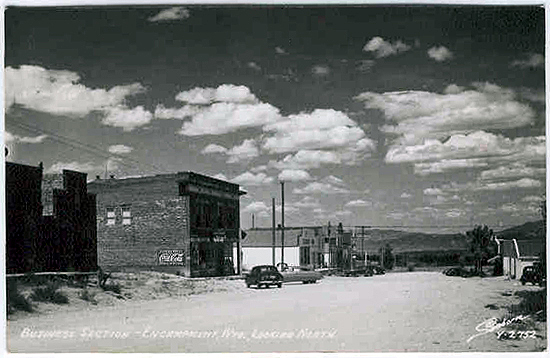
Encampment, approx. 1949.
In 2004, the Wyoming Rural Development Council released an assessment report on Encampment with recommendations on improving development of the Valley.
The report noted that as of 2003, Encampment was supported by timber, ranching and recreation industries. Nevertheless, the
Report noted that most of the streets in the town were dirt and there were only ten businesses still open in town. At the time, the
population was estimated at 426. As of 2013, the population is approximately 450.
Music this page: Beautiful Isle of Somewhere, courtesy of Horse Creek Cowboy.
Next page, Encampment continued.
|